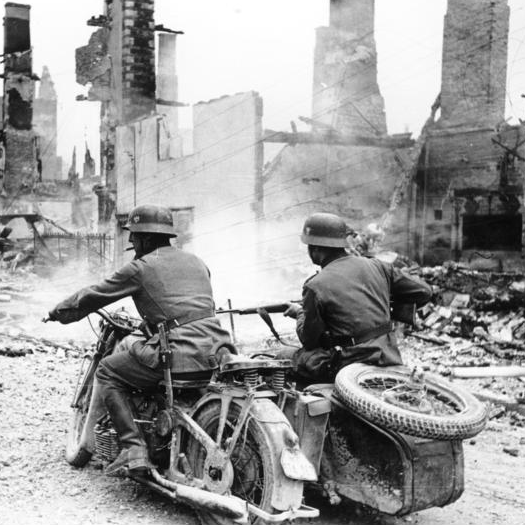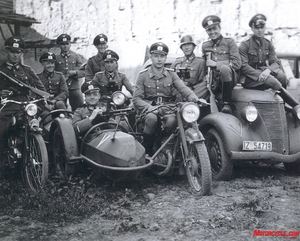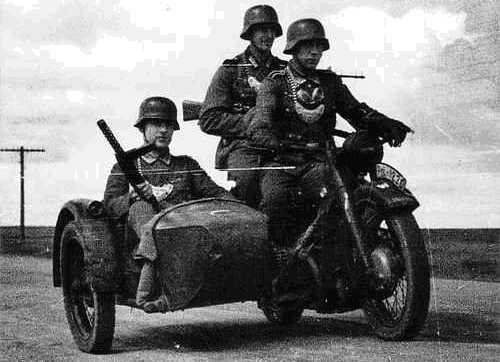FOW: Kradschutzen- The Good, The Bad, & The German

 Everyone seems completely enamored by the Motorcycle troops in Blitzkrieg. Are they really as good as they’re made out to be?
Everyone seems completely enamored by the Motorcycle troops in Blitzkrieg. Are they really as good as they’re made out to be?Let’s dissect the Reich’s motorcycle troops!
This assessment goes pretty much the same for the other motorcycle troops, but the Kradschutzen are just too cool to pass up! In this article we’ll briefly talk about modeling, and then focus on “The Good”, “The Bad”, and “The German”
*Teams are treated as recce while mounted. This is another very beneficial rule for your bikers, allowing them a variety of perks. For starters, you may make a recce move at the beginning of the game. Additionally, you gain all the benefits of recce such as: “Eyes and Ears” Where you can lift gone to ground of enemy units within 16” so long as you don’t move or shoot, “Disengage” where you can make a skill check to avoid getting shot to pieces, and “Cautious movement” so your troops can be gone to ground even if they move so long as they are in concealing terrain and do not shoot!
 THE BAD
THE BADEvery rose has its thorn, and the kradschutzen are no exception. So now that I’ve instilled visions of your motorcycle troops racing to glory in the french countryside, allow me to dash said hopes by discussing the drawbacks of these bikers.
*Large Footprint. MG, Rifle/MG, and Rifle kradschutzen guys are mounted on large bases while on their bikes. The command teams, AT Rifle, and Light Mortars are mounted on medium bases. This means for a typical kradschutzen platoon, you will have SIX large bases and three medium bases. That is a hell of a footprint- as large or larger than most nations’ artillery batteries!
*Difficult to Conceal. Because these guys are recon, you’re going to want to keep them in concealment when not shooting, but several factors conspire against you. As previously discussed, their large footprint makes them very difficult to conceal. Additionally, their mobility is actually worse than infantry when moving through rough terrain (as most concealing terrain is). Because they use “jeep” mobility, they only go 4″ through difficult terrain, significantly slowing them down!
*Sometimes being recce is a drawback. I am specifically referring to “forced to disengage” here. If your motorcyclists get shot up any, they have to pass a motivation check or they are forced to disengage. This is bad- it means you’ll have to spend your next turn “reorganizing”- effectively costing you a whole turn! And since your troops are only confident, 50% of the time you get shot up (and fail a save) this will happen!
*Point cost. Those sweet motorcycles don’t come free! In fact, it costs about 30% extra to get the motorcycles, which adds up over several platoons. And remember- once you dismount, that’s it for the rest of the game. Your motorcycles are gone.
 Clearly the Kradschutzen give an Early War German player something to think about. I think most of the drawbacks can be mitigated through judicious use of stormtroopers and cautious movement, but I also think situations where you don’t get to use the motorcycles are going to really hurt. Those points are always precious (just ask any Armored Panzergrenadier player how they feel when their halftracks need to be off the board)
Clearly the Kradschutzen give an Early War German player something to think about. I think most of the drawbacks can be mitigated through judicious use of stormtroopers and cautious movement, but I also think situations where you don’t get to use the motorcycles are going to really hurt. Those points are always precious (just ask any Armored Panzergrenadier player how they feel when their halftracks need to be off the board)
On the whole I am on the fence about Kradschutzen. I think a single platoon of them supporting another company is a solid choice, but an entire company might be difficult to work. The modeling possibilities have me salivating, but the actual troops themselves give me pause. Time will tell if solid tactics emerge to use these guys effectively, and I can’t wait to see how they play out.






